Energy and Entropy Analyses of a Pilot-Scale Dual Heating HDH Desalination System
Abstract
:1. Introduction
2. System Description
3. Mathematical Model
- The processes involved in the cycle operate at steady state conditions.
- Negligible heat loss occurs through the subcomponents, in the cycle.
- Power needed to operate the pump and fan is minimal in comparison to the input required by heating unit.
- Produced freshwater is expected to leave the dehumidifier at a mean temperature between the temperature of humid air at the entrance and temperature of air at the exit.
- Relative humidity of air that leaves both the system subcomponents is assumed to be >90%. Since, air gets heated and humidified simultaneously in an evaporator. Similarly, air loses heat and moisture as it flows through the dehumidifier.
Governing Equations
4. Results and Discussion
4.1. Model Validation with Experimental Data
4.2. Entropy Analysis
5. Conclusions
- Results of the theoretical model have been validated against the experimental outcomes, and the model was found to be in a good agreement with the experimental findings. It has been found that the maximum overall percentage deviation from the model is within 11.5% of the experimental data.
- The concept of heat rate ratio Qr is introduced, which signifies the effect of total energy distribution between water and air streams, in dual heated systems. It is deduced that the system performs better when heat rate ratio is greater than one or when more energy is supplied to the water stream.
- There exists an optimal mass flowrate ratio at which GOR is maximized, and entropy generation is minimized.
- The specific entropy generation within the humidifier is low and approaches zero, while the degree of irreversibilities within other components are quite high and are of the same order of magnitude.
- Both energy (GOR) and entropy analysis revealed that dual heated HDH system with heat rate ratio greater than unity is better that dual heated HDH system with heat rate ratio lower than unity.
Author Contributions
Funding
Data Availability Statement
Acknowledgments
Conflicts of Interest
Nomenclature
| Symbols | |
| h | specific enthalpy (kJ/kg) |
| hfg | latent heat of vaporization (kJ/kg) |
| GOR | gain output ratio |
| MR | mass flowrate ratio |
| ṁw | feedwater mass flowrate (kg/s) |
| ṁpw | freshwater mass flowrate (kg/s) |
| ṁb | brine mass flowrate (kg/s) |
| ṁa | dry air mass flowrate (kg/s) |
| in | rate of heat input (kW) |
| Qr | heat rate input ratio [in,water/in,air] (-) |
| s | specific entropy (kJ/kg.K) |
| gen | entropy generation rate (kW/K) |
| gen | specific entropy generation (kJ/kg.K) |
| T | temperature (C) |
| ε | effectiveness (-) |
| ω | humidity ratio (kgw/kga) |
| Subscripts | |
| a | air |
| d | dehumidifier |
| h | humidifier |
| ht | heater |
| Hum./Deh. | humidifier/dehumidifier |
| w | water |
References
- Lawal, D.U.; Qasem, N.A.A. Humidification-dehumidification desalination systems driven by thermal-based renewable and low-grade energy sources: A critical review. Renew. Sustain. Energy Rev. 2020, 125, 109817. [Google Scholar] [CrossRef]
- Narayan, G.P.; Lienhard, V.J.H. Humidification Dehumidification Desalination. In Desalination: Water from Water; Kucera, I.J., Ed.; Wiley-Scrivener: Salem, MA, USA, 2014; pp. 425–472. [Google Scholar]
- Bourouni, K.; Martin, R.; Tadrist, L.; Chaibi, M.T. Heat transfer and evaporation in geothermal desalination units. Appl. Energy 2002, 64, 129–147. [Google Scholar] [CrossRef]
- Eslamimanesh, A.; Hatamipour, M.S.; Eslamimanesh, A.H.M. Mathematical modeling of a direct contact humidification-dehumidification desalination process. Desalination 2009, 237, 296–304. [Google Scholar] [CrossRef]
- De Oliveira Campos, B.L.; da Costa, A.O.S.; da Costa Junior, E.F. Mathematical modeling and sensibility analysis of a solar humidification-dehumidification desalination system considering saturated air. Sol. Energy 2017. [Google Scholar] [CrossRef]
- Hermosillo, J.J.; Arancibia-Bulnes, C.A.; Estrada, C.A. Water desalination by air humidification: Mathematical model and experimental study. Sol. Energy 2012, 86, 1070–1076. [Google Scholar] [CrossRef]
- Zubair, M.I.; Al-Sulaiman, F.A.; Antar, M.A.; Al-Dini, S.A.; Ibrahim, N.I. Performance and cost assessment of solar driven humidification dehumidification desalination system. Energy Convers. Manag. 2016, 132, 28–39. [Google Scholar] [CrossRef]
- Sharqawy, M.H.; Antar, M.A.; Zubair, S.M.; Elbashir, A.M. Optimum thermal design of humidification dehumidification desalination systems. Desalination 2014, 349, 10–21. [Google Scholar] [CrossRef]
- Lawal, D.; Antar, M.; Khalifa, A.; Zubair, S.; Al-Sulaiman, F. Humidification-dehumidification desalination system operated by a heat pump. Energy Convers. Manag. 2018, 161, 128–140. [Google Scholar] [CrossRef]
- Lawal, D.U.; Zubair, S.M.; Antar, M.A. Exergo-economic analysis of humidification-dehumidification (HDH) desalination systems driven by heat pump (HP). Desalination 2018, 443, 11–25. [Google Scholar] [CrossRef]
- Muthusamy, C.; Srithar, K. Energy and exergy analysis for a humidification-dehumidification desalination system integrated with multiple inserts. Desalination 2015, 367, 49–59. [Google Scholar] [CrossRef]
- Alhazmy, M.M. Minimum work requirement for water production in humidification-dehumidification desalination cycle. Desalination 2007, 214, 102–111. [Google Scholar] [CrossRef]
- Mistry, K.H.; Lienhard, J.H.; Zubair, S.M. Effect of entropy generation on the performance of humidification-dehumidification desalination cycles. Int J. Therm. Sci. 2010, 49, 1837–1847. [Google Scholar] [CrossRef] [Green Version]
- Ashrafizadeh, S.A.; Amidpour, M. Exergy analysis of humidification-dehumidification desalination systems using driving forces concept. Desalination 2012, 285, 108–116. [Google Scholar] [CrossRef]
- Lawal, D.U.; Antar, M.A.; Khalifa, A.E. Integration of a MSF Desalination System with a HDH System for Brine Recovery. Sustainability 2021, 13, 3506. [Google Scholar] [CrossRef]
- Mahdizade, E.Z.; Ameri, M. Thermodynamic investigation of a semi-open air, humidification dehumidification desalination system using air and water heaters. Desalination 2018, 428, 182–198. [Google Scholar] [CrossRef]
- Deniz, E.; Çınar, S. Energy, exergy, economic and environmental (4e) analysis of a solar desalination system with humidification-dehumidification. Energy Convers. Manag. 2016, 126, 12–19. [Google Scholar] [CrossRef]
- Khalil, A.; El-Agouz, S.A.; El-Samadony, Y.A.F.; Abdo, A. Solar water desalination using an air bubble column humidifier. Desalination 2015, 372, 7–16. [Google Scholar] [CrossRef]
- Zubair, S.M.; Antar, M.A.; Elmutasim, S.M.; Lawal, D.U. Performance evaluation of humidification-dehumidification (HDH) desalination systems with and without heat recovery options: An experimental and theoretical investigation. Desalination 2018, 436, 161–175. [Google Scholar] [CrossRef]
- Hamed, M.H.; Kabeel, A.E.; Omara, Z.M.; Sharshir, S.W. Mathematical and experimental investigation of a solar humidification–dehumidification desalination unit. Desalination 2015, 358, 9–17. [Google Scholar] [CrossRef]
- Wu, G.; Zheng, H.; Ma, X.; Kutlu, C.; Su, Y. Experimental investigation of a multi-stage humidification-dehumidification desalination system heated directly by a cylindrical Fresnel lens solar concentrator. Energy Convers. Manag. 2017, 143, 241–251. [Google Scholar] [CrossRef]
- Lawal, D.U.; Antar, M.A.; Aburub, A.; Aliyu, M. Performance assessment of a cross-flow packed-bed humidification-dehumidification (HDH) desalination system—The effect of mass extraction. Desalin. Water Treat. 2018, 104, 28–37. [Google Scholar] [CrossRef]
- Aburub, A.; Aliyu, M.; Lawal, D.U.; Antar, M. Experimental investigations of a cross-flow humidification dehumidification desalination system. Int. Water Technol. J. IWTJ 2017, 7, 198–208. [Google Scholar]
- Shafii, M.B.; Jafargholi, H.; Faegh, M. Experimental investigation of heat recovery in a humidification-dehumidification desalination system via a heat pump. Desalination 2018, 437, 81–88. [Google Scholar] [CrossRef]
- Zhang, Y.; Zhang, H.; Zheng, W.; You, S.; Wang, Y. Numerical investigation of a humidification-dehumidification desalination system driven by heat pump. Energy Convers. Manag. 2019, 80, 641–653. [Google Scholar] [CrossRef]
- Dehghani, S.; Date, A.; Akbarzadeh, A. Performance analysis of a heat pump driven humidification-dehumidification desalination system. Desalination 2018, 445, 95–104. [Google Scholar] [CrossRef]
- Zhang, Y.; Zhu, C.; Zhang, H.; Zheng, W.; You, S.; Zhen, Y. Experimental study of a humidification-dehumidification desalination system with heat pump unit. Desalination 2018, 442, 108–117. [Google Scholar] [CrossRef]
- Faegh, M.; Shafii, M.B. Performance evaluation of a novel compact humidification-dehumidification desalination system coupled with a heat pump for design and off-design conditions. Energy Convers. Manag. 2019, 194, 160–172. [Google Scholar] [CrossRef]
- Lawal, D.U.; Antar, M.A.; Khalifa, A.; Zubair, S.M. Heat pump operated humidification-dehumidification desalination system with option of energy recovery. Sep. Sci. Technol. 2020, 55, 1–19. [Google Scholar] [CrossRef]

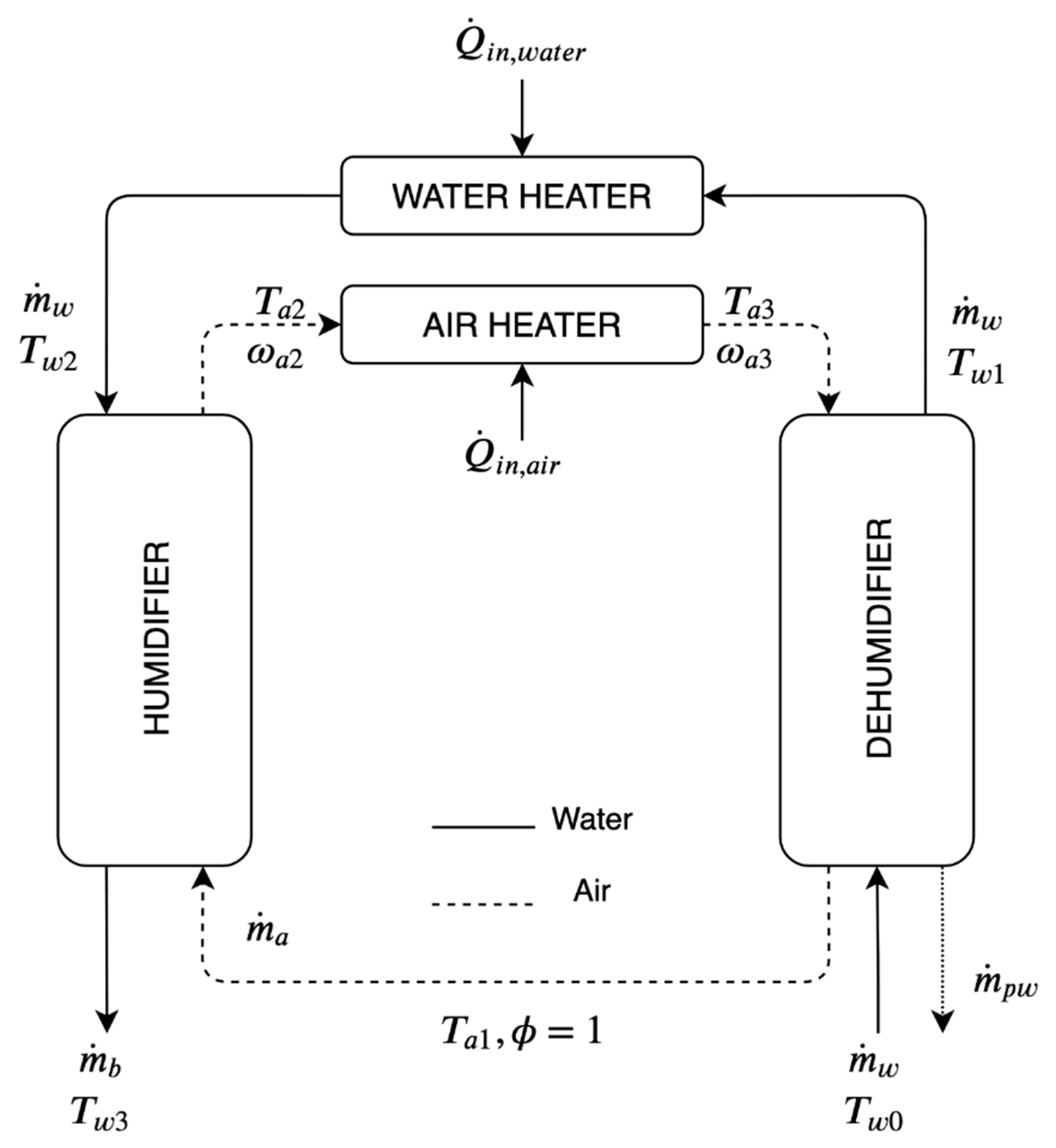
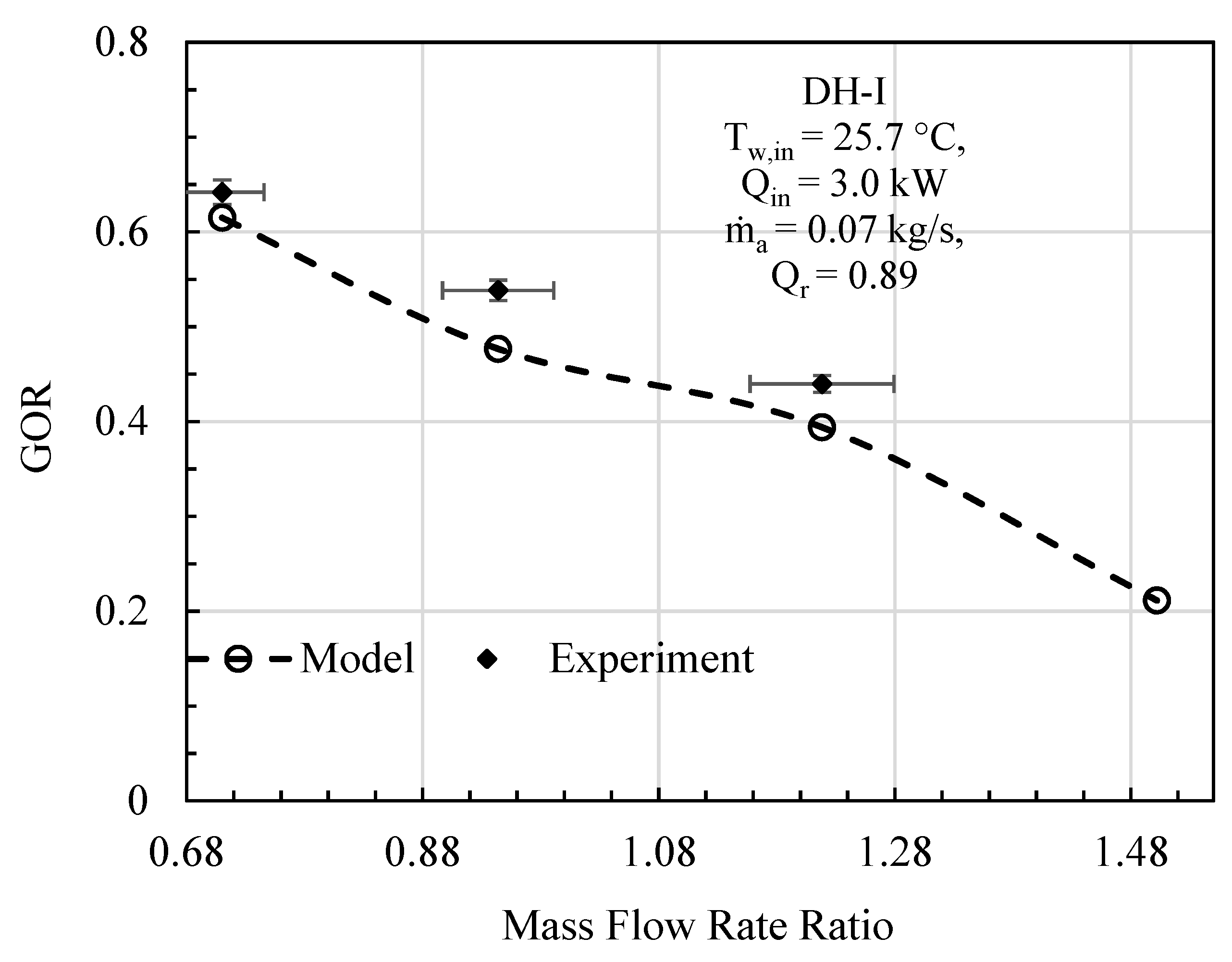
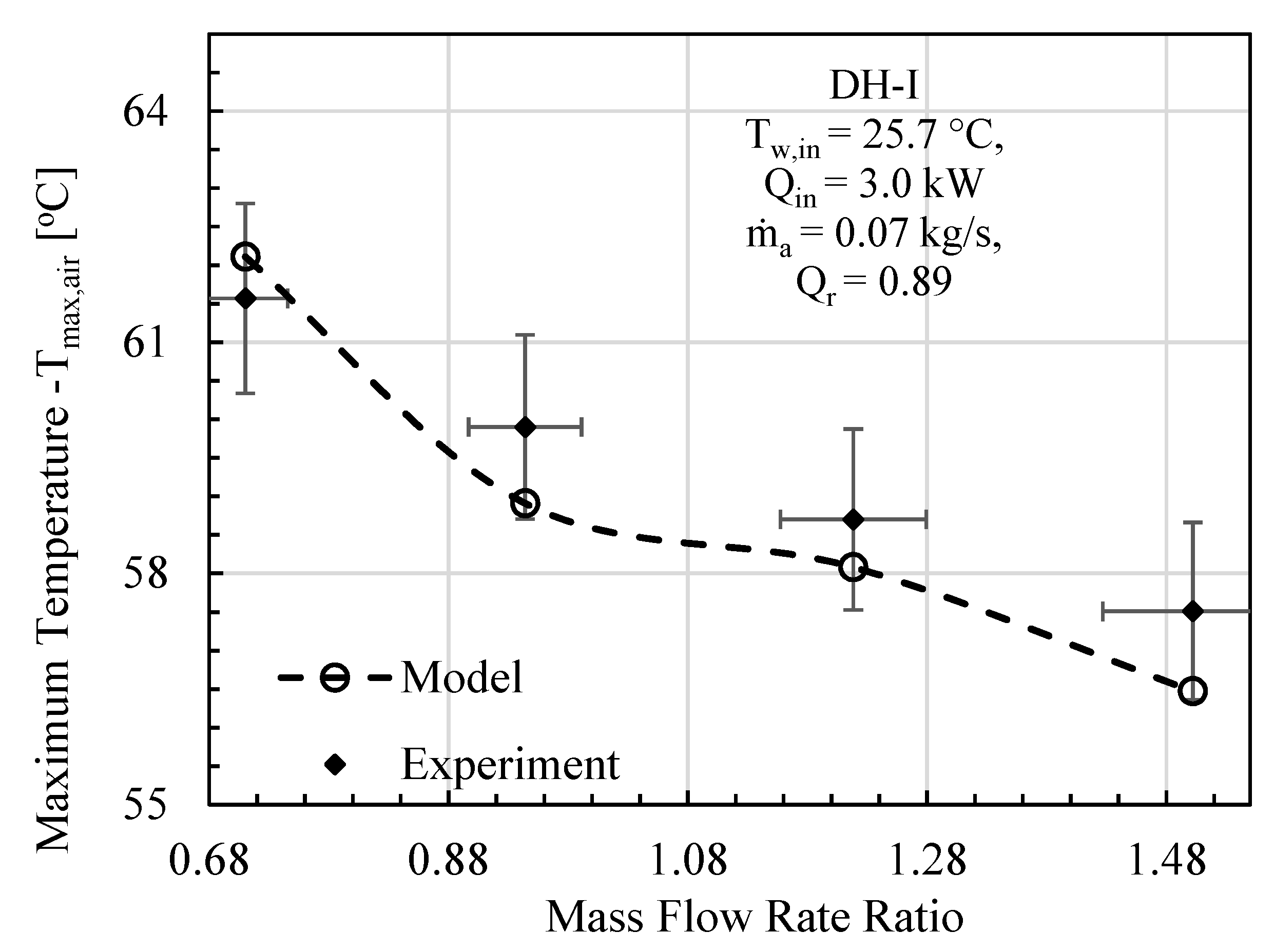
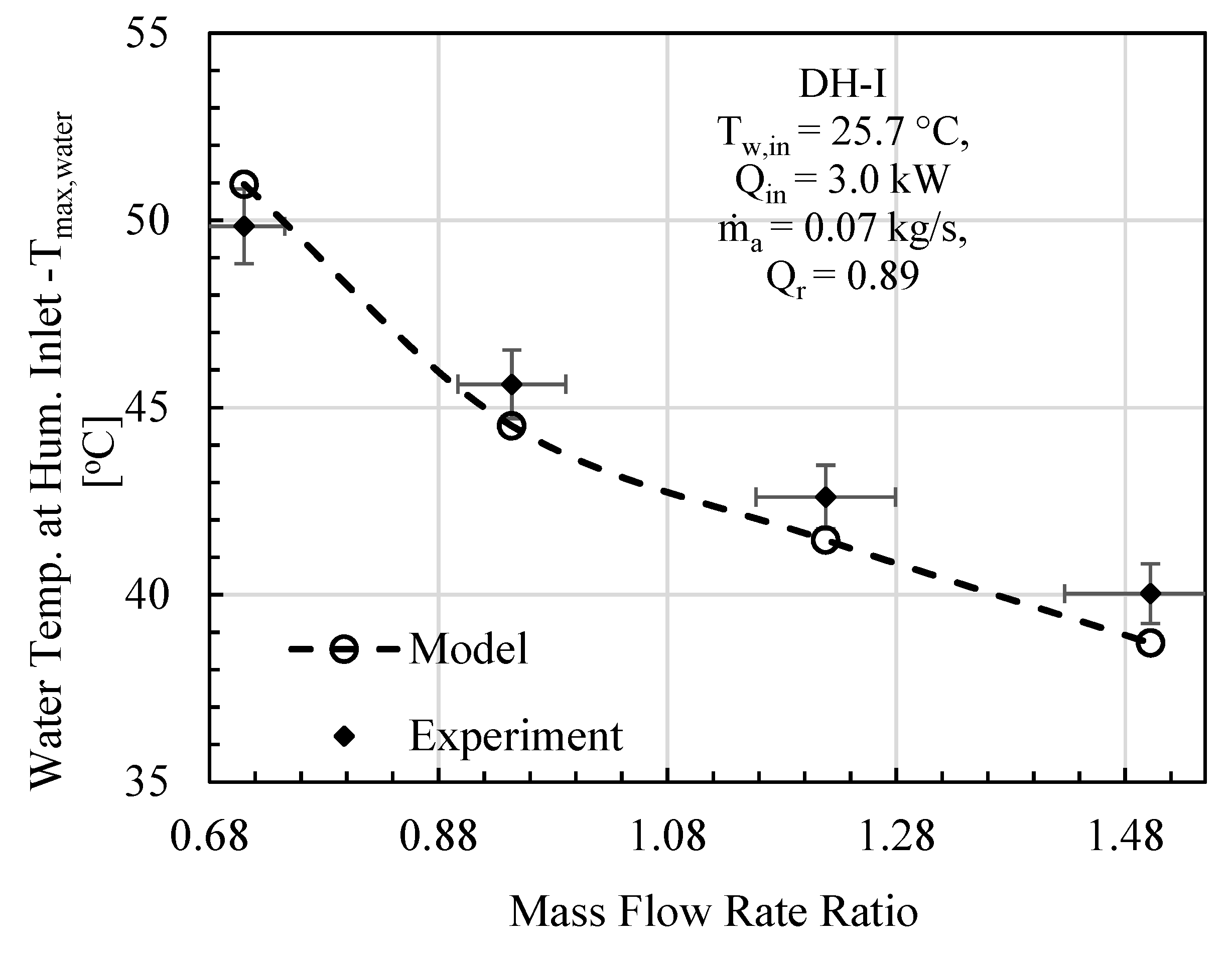

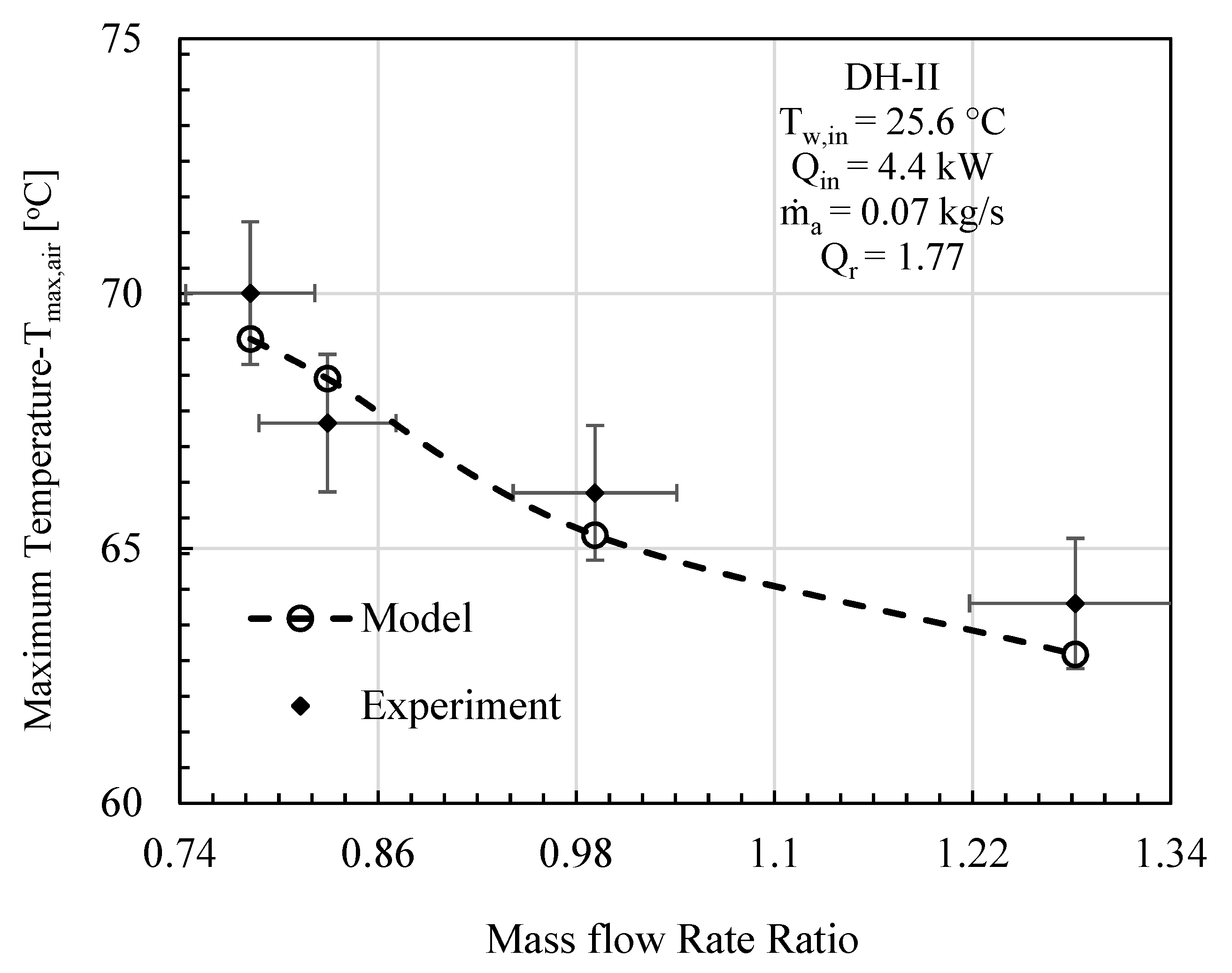



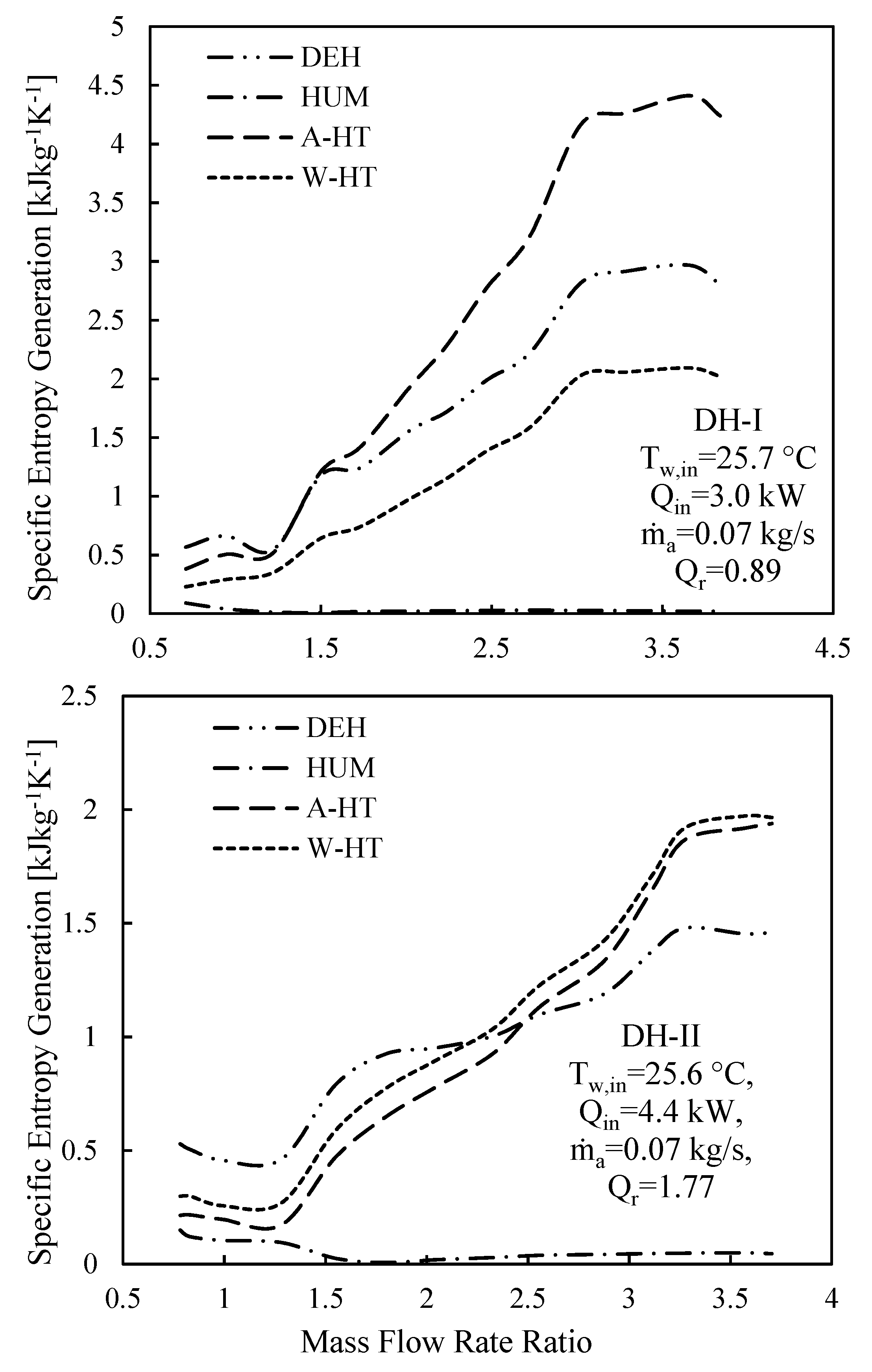
| Energy Source | GOR | Ref |
|---|---|---|
| Solar Energy (Experiment) | 2.2 | [20] |
| Solar Energy (Experiment) | 2.1 | [21] |
| Solar Energy (Experiment) | 0.3154 | [17] |
| Solar Energy (Experiment) | 0.53 | [18] |
| Electric Heater (Experiment) | 0.42 | [19] |
| Electric Heater (Experiment) | 2.7 | [22] |
| Electric Heater (Experiment) | 1.3 | [23] |
| Heat Pump (Experiment) | 2.08 | [24] |
| Heat Pump (Theory) | 2.532 | [25] |
| Heat Pump (Theory) | 0.76 | [26] |
| Heat Pump (Experiment) | 2.05 | [27] |
| Heat Pump (Theory) | 2.476 | [28] |
| Heat Pump (Theory) | 3.91 | [29] |
| Electric Heater (Experiment) | 0.756 | Present |
Publisher’s Note: MDPI stays neutral with regard to jurisdictional claims in published maps and institutional affiliations. |
© 2021 by the authors. Licensee MDPI, Basel, Switzerland. This article is an open access article distributed under the terms and conditions of the Creative Commons Attribution (CC BY) license (https://creativecommons.org/licenses/by/4.0/).
Share and Cite
Lawal, D.U.; Abdul Jawad, S.; Sharqawy, M.H.; Antar, M.A. Energy and Entropy Analyses of a Pilot-Scale Dual Heating HDH Desalination System. Entropy 2021, 23, 1282. https://doi.org/10.3390/e23101282
Lawal DU, Abdul Jawad S, Sharqawy MH, Antar MA. Energy and Entropy Analyses of a Pilot-Scale Dual Heating HDH Desalination System. Entropy. 2021; 23(10):1282. https://doi.org/10.3390/e23101282
Chicago/Turabian StyleLawal, Dahiru U., Saad Abdul Jawad, Mostafa H. Sharqawy, and Mohamed A. Antar. 2021. "Energy and Entropy Analyses of a Pilot-Scale Dual Heating HDH Desalination System" Entropy 23, no. 10: 1282. https://doi.org/10.3390/e23101282






